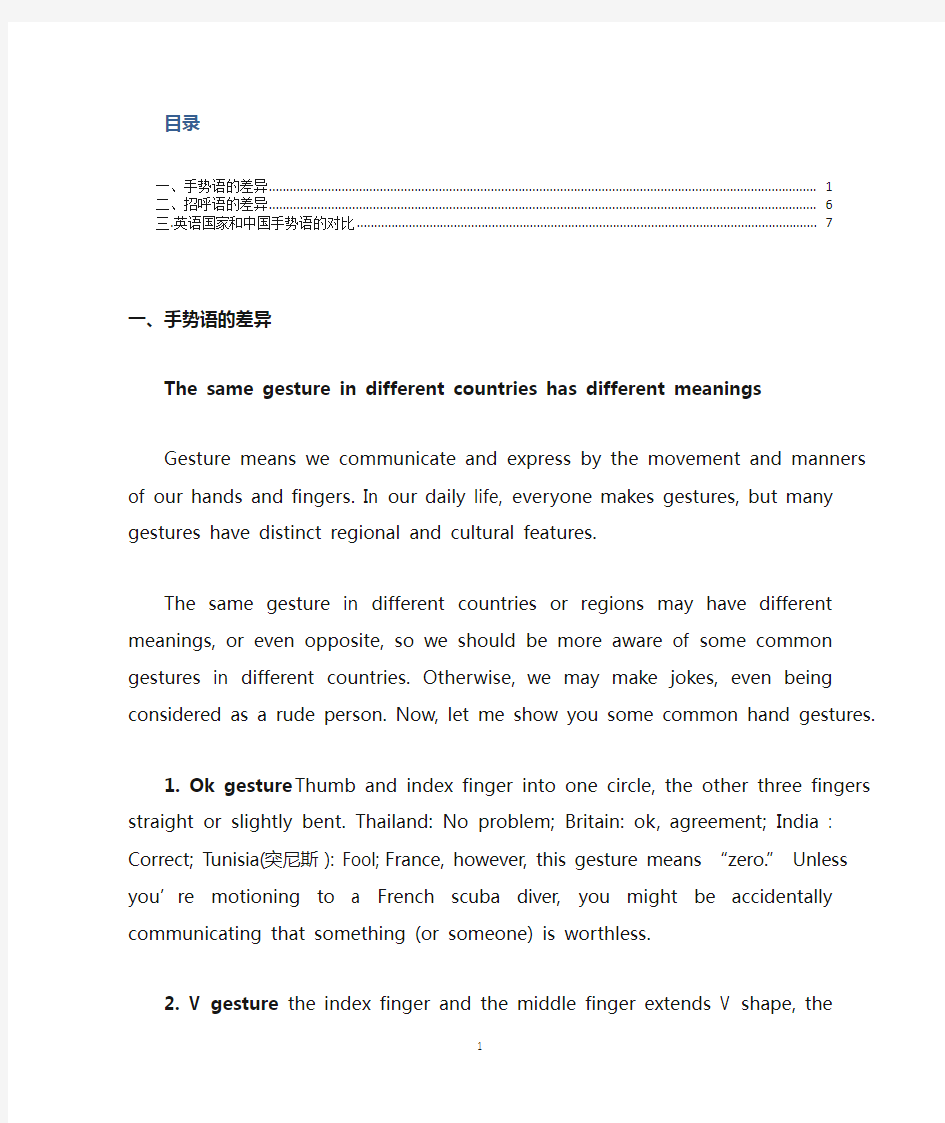不同国家手势 问候语的不同

- 1、下载文档前请自行甄别文档内容的完整性,平台不提供额外的编辑、内容补充、找答案等附加服务。
- 2、"仅部分预览"的文档,不可在线预览部分如存在完整性等问题,可反馈申请退款(可完整预览的文档不适用该条件!)。
- 3、如文档侵犯您的权益,请联系客服反馈,我们会尽快为您处理(人工客服工作时间:9:00-18:30)。
目录
一、手势语的差异 (1)
二、招呼语的差异 (6)
三.英语国家和中国手势语的对比 (8)
一、手势语的差异
The same gesture in different countries has different meanings Gesture means we communicate and express by the movement and manners of our hands and fingers. In our daily life, everyone makes gestures, but many gestures have distinct regional and cultural features. The same gesture in different countries or regions may have different meanings, or even opposite, so we should be more aware of some common gestures in different countries. Otherwise, we may make jokes, even being considered as a rude person. Now, let me show you some common hand gestures.
1. Ok gesture Thumb and index finger into one circle, the other three fingers straight or slightly bent. Thailand: No problem; Britain: ok, agreement; India : Correct; Tunisia(突尼斯): Fool; France, however, this gesture means “zero.” Unless you’re motioning to a French scuba diver, you might be accidentally communicating that something (or someone) is worthless.
2. V gesture the index finger and the middle finger extends V shape, the thumb curving pressure on the ring finger and the little finger. Majority places: expresses two when we count, means victory ( it is said that British Prime Minister Churchill(丘吉尔)who was the first one use like that in the world war two) We should note the following two points: When it expresses victory, the palm must be out. If the palm inward, that is demeaning(堕落), insulting(侮辱)meaning. In Greece, we make the gesture , even though the palms outward , such as the arms straight , but it still be suspected to be a contempt (轻蔑)
3. Left or right hand fist, index finger straight. Majority countries: The number one; France: Request question; Singapore: The most important; Australia: another beer please;America:Wait a minute.
4.yes/ no in most parts of the world, nodding the head up and down means "yes“; shaking the head means "no”. However, in Bulgaria(保加利亚), their habits is just the opposite. They nod and say "no"; they shake their head and say “yes“.
5. Lifting the thumb. In China: good, great, there is appreciation, praise meaning; Italy: the number one; Greece: thumbs up, means enough , disgust, bad guys; United States, Britain , Australia and other countries : good , OK. However, try to avoid it in Thailand, though, where it’s a sign of condemnation. It’s typically a child’s gesture, the Thai equivalent of sticking out your tongue. People will likely be more bemused than hurt if
you slip up. Still, it’s a good one to avoid.
6. Waving the hand United States: the North American people , whether in greeting or farewell to the people , or just to arouse people's attention far away from him , they lift arm, open hand back and forth Europeans say hello or goodbye when they lift arm, waving the hand at the wristup and down , like basketball players dribble moves .
7. Raise one’s little finger In China, raising one’s little finger means bad or look down on somebody. In Japan, people raise their little fingers to express one is their lover.在菲律宾表示小个子、年轻或表示对方是小人物;在泰国、沙特阿拉伯表示朋友;在缅甸、印度表示要去厕所;在英国表示懦弱的男人;在美国、韩国、尼日利亚还可以表示打赌。
8. Displaying your palms in Greece
We use this gesture in North America to say “stop,” or, if you’re a child of the Jerry Springer era, “talk to the hand.” In Greece, keep your palms to yourself. Holding your palms out towards a person is a highly insulting gesture. This gesture is said to be a remnant of Byzantine times, when people could taunt shackled criminals by smearing their faces with excrement.
9. Beckoning in the Philippines
Curling your index finger to say “come here” is a no-no in many Asian countries. In the Philippines, this gesture is only used for dogs. To use it with a person is derogatory; suggesting that you see them as a
